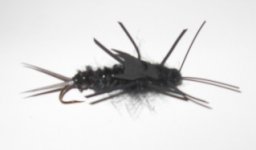F
Fishidiot
Active member
- Joined
- Sep 9, 2006
- Messages
- 9,960
It seems to me - based on my entirely unscientific and sloppy trout stream rock rolling escapades - that stonefly nymphs are a bit more abundant down here in the southcentral part of the state than they were in years past. However, one bug I didn't see a single example of this year in PA was a giant stonefly. I'm referring to the very large, dark, round bodied nymphs commonly known as "salmonflies" out West. I believe the correct scientific nomenclature of the western bug is Pteronarcys califonica. The back east version here in PA is, I believe, P. dorsata.
Like many of you, these big stonefly nymphs are a go-to fly for me out West and have produced some memorable days for me - the Gunnison River one day in June a few years ago sticks out in my memory. I always have a few of the big nymphs in my box, but rarely use 'em here in PA. Most of my trout fishing and rock rolling is here in the SC part of the state and I have, in past years, seen some of these nymphs on my local waters (Big Hunting Creek has 'em along with some other freestoners).
I guess my question is: For those of you who search for and are interested in trout stream nymphs (hey, Old Lefty!) are you seeing this bug here in PA? What about different regions of the state? I think that larger species of stoneflies are more common in the northcentral part of the state. I'm amazed at the number of generic stoneflies under rocks in Penns Creek. But what about giant stoneflies?
Anyway, for what it's worth, here's one of these rascals I tied yesterday evening. Don't know if I'll tie one on in PA this year.
Like many of you, these big stonefly nymphs are a go-to fly for me out West and have produced some memorable days for me - the Gunnison River one day in June a few years ago sticks out in my memory. I always have a few of the big nymphs in my box, but rarely use 'em here in PA. Most of my trout fishing and rock rolling is here in the SC part of the state and I have, in past years, seen some of these nymphs on my local waters (Big Hunting Creek has 'em along with some other freestoners).
I guess my question is: For those of you who search for and are interested in trout stream nymphs (hey, Old Lefty!) are you seeing this bug here in PA? What about different regions of the state? I think that larger species of stoneflies are more common in the northcentral part of the state. I'm amazed at the number of generic stoneflies under rocks in Penns Creek. But what about giant stoneflies?
Anyway, for what it's worth, here's one of these rascals I tied yesterday evening. Don't know if I'll tie one on in PA this year.





